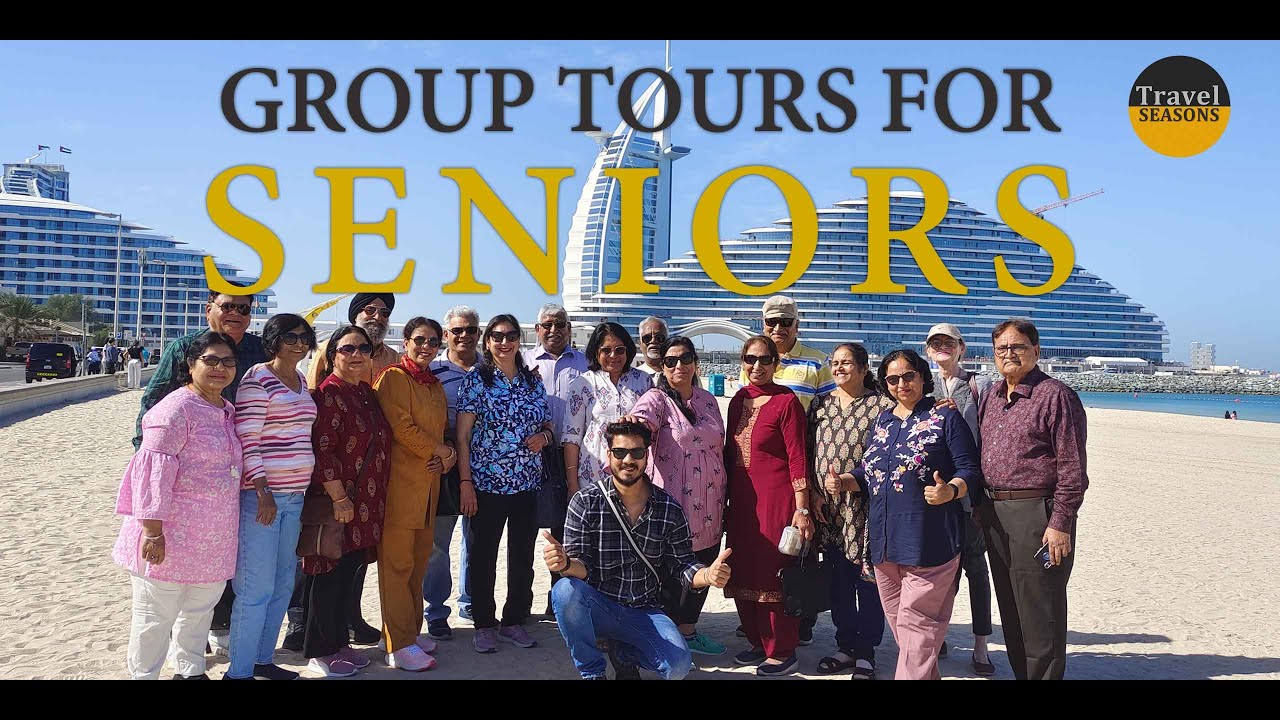Senior travel tour groups represent a significant and growing market segment. This exploration delves into the diverse offerings, marketing strategies, and customer experiences shaping this sector. We’ll examine the various types of tours catering to seniors’ preferences, from adventurous expeditions to relaxing cultural immersions, and analyze the factors contributing to successful and memorable travel experiences for this demographic.
Understanding the unique needs and desires of senior travelers is crucial for tour operators. This includes accessibility considerations, engaging activities tailored to varying fitness levels, and the importance of experienced and knowledgeable guides. Successfully navigating this market requires a keen understanding of marketing channels that resonate with this audience, effective communication, and a commitment to exceeding customer expectations.
Market Analysis of Senior Travel Tour Groups
The senior travel market is experiencing significant growth, driven by increasing longevity, improved health among older adults, and a desire for enriching experiences in retirement. This analysis explores the current state and future potential of this dynamic sector, focusing on key demographics, tour types, pricing strategies, and popular destinations.
Market Size and Growth Potential
The senior travel market (defined as travelers aged 65 and older) represents a substantial and expanding segment of the overall tourism industry. While precise figures vary depending on the source and definition, reports consistently show robust growth. For example, the AARP has projected continued strong growth in the coming years, fueled by the aging baby boomer population. This growth is not uniform across all segments, with certain niche markets experiencing even more rapid expansion. Factors such as disposable income levels and evolving travel preferences significantly influence this growth trajectory. Predicting precise numbers is challenging due to economic fluctuations and unforeseen global events, but the overall trend points towards continued expansion.
Key Demographics of Senior Travelers
Senior travelers participating in group tours exhibit diverse characteristics. The largest segment generally consists of individuals aged 65-75, often retired couples or groups of friends. However, a growing number of solo senior travelers are also participating, seeking independence and social interaction. Education levels and income levels significantly influence travel choices, with higher-income seniors often opting for more luxurious and extensive tours. Health considerations are also paramount, with tour operators catering to varying levels of physical ability and accessibility needs. Geographic location influences destination choices, with proximity playing a role for those with mobility concerns.
Types of Senior Travel Tour Groups
The senior travel market offers a wide array of tour options catering to diverse interests and preferences. Relaxation-focused tours often feature cruises, spa retreats, or all-inclusive resort stays, prioritizing comfort and rejuvenation. Adventure tours, on the other hand, might include hiking, wildlife safaris, or active cultural immersion experiences. Cultural tours focus on historical sites, museums, and local traditions, offering educational and enriching experiences. Other specialized tours might cater to specific interests like culinary experiences, photography tours, or religious pilgrimages. The diversity of options reflects the varied preferences and abilities within the senior traveler demographic.
Pricing Strategies of Tour Operators
Tour operators employ diverse pricing strategies to attract various segments of the senior travel market. Some emphasize value-for-money packages, including flights, accommodation, and excursions at competitive rates. Others focus on luxury offerings, providing high-end accommodations, exclusive experiences, and personalized services at premium prices. Many operators offer flexible payment plans or discounts for early bookings to incentivize purchases. Pricing also varies based on destination, tour duration, and the level of included services. Competition among tour operators influences pricing, leading to a range of options to suit different budgets and preferences.
Market Segments, Growth Rates, Average Trip Costs, and Popular Destinations
| Market Segment | Estimated Annual Growth Rate (%) | Average Trip Cost (USD) | Popular Destinations |
|---|---|---|---|
| Relaxation Tours | 5-7% | $3,000 – $8,000 | Caribbean Islands, Mediterranean cruises, Hawaii |
| Cultural Tours | 6-8% | $4,000 – $10,000 | Europe (Italy, France, Spain), Southeast Asia, South America |
| Adventure Tours | 8-10% | $5,000 – $15,000 | National Parks (USA, Canada, Australia), African safaris, South American trekking |
| Luxury Tours | 4-6% | $10,000+ | Private villas in the Mediterranean, luxury cruises, exclusive resorts |
Tour Features and Services
Senior travel tours are designed to provide a comfortable and enriching experience, catering specifically to the needs and preferences of older adults. These tours go beyond simply arranging transportation and accommodation; they offer a comprehensive package of services aimed at enhancing the overall travel experience and ensuring a memorable journey.
Essential Features and Services
A successful senior travel tour incorporates a range of essential features and services. These are carefully chosen to address the unique requirements of this demographic, prioritizing comfort, safety, and ease of travel. The following list highlights key elements:
- Comfortable Transportation: This typically involves air-conditioned motorcoaches with ample legroom and restroom facilities, designed for comfortable long-distance travel. In some cases, private car transfers may be included for shorter distances.
- High-Quality Accommodation: Hotels are carefully selected based on factors such as accessibility, proximity to attractions, and overall comfort. This often includes hotels with elevators, easily accessible rooms, and amenities like grab bars in bathrooms.
- Comprehensive Itinerary: A well-structured itinerary is crucial, balancing sightseeing with relaxation and downtime. It should include details about timings, locations, and activities, allowing participants to plan their days effectively.
- Meals: Many tours include breakfast daily and often incorporate other meals, offering a variety of options to cater to different dietary needs and preferences. This can include pre-arranged meals at restaurants or picnic lunches during excursions.
- Experienced Tour Guides: Knowledgeable and experienced tour guides are integral to the success of any senior travel tour. Their expertise in history, culture, and local customs enhances the learning experience.
- Travel Insurance: Comprehensive travel insurance is often included or strongly recommended, providing peace of mind in case of unforeseen circumstances such as medical emergencies or trip cancellations.
- 24/7 Support: Access to a dedicated support team available around the clock provides assistance with any issues or concerns that may arise during the trip.
Accessibility Features for Seniors with Mobility Issues
Accessibility is paramount in senior travel. Tours should be designed to accommodate individuals with varying levels of mobility. This includes features such as:
- Accessible Transportation: Vehicles with ramps, lifts, and ample space for wheelchairs and walkers are essential. This ensures that everyone can comfortably reach their destination.
- Accessible Accommodation: Hotels should offer rooms with roll-in showers, grab bars, and wider doorways. Elevators are a must for multi-story hotels.
- Pace of Activities: The pace of the tour should be manageable for all participants, allowing ample time for rest and relaxation. Activities should be chosen with mobility limitations in mind.
- Assistance: Tours may provide assistance with baggage handling, mobility aids, and other support services as needed.
The Role of Experienced and Knowledgeable Tour Guides
Experienced and knowledgeable tour guides play a crucial role in creating a memorable travel experience. They are more than just drivers or itinerary managers; they act as storytellers, cultural interpreters, and problem solvers. Their expertise in local history, culture, and customs enriches the journey, making it both informative and engaging. They also provide invaluable assistance to participants, ensuring a smooth and hassle-free experience. A skilled tour guide anticipates potential problems, manages logistics effectively, and provides personalized attention to individual needs.
Unique and Engaging Activities Offered on Senior Travel Tours
Senior travel tours often incorporate unique and engaging activities designed to cater to the interests and abilities of older adults. These can include:
- Gentle Walking Tours: Exploring historical sites or charming neighborhoods at a relaxed pace, allowing for frequent rest stops.
- Cooking Classes: Learning to prepare local dishes in a hands-on cooking class, providing a cultural and culinary experience.
- Wine Tasting Tours: Visiting vineyards and enjoying wine tastings, accompanied by informative commentary about the winemaking process.
- Visits to Historical Sites and Museums: Exploring significant historical landmarks and museums, with guided tours providing context and enriching the experience.
- Relaxation and Wellness Activities: Incorporating activities such as spa treatments, yoga sessions, or guided meditation to promote relaxation and well-being.
Sample Seven-Day Senior Travel Tour Itinerary
This itinerary is a sample and could be adapted to different destinations and interests.
| Day | Activity | Features & Services |
|---|---|---|
| 1 | Arrival in Florence, Italy; Check-in to hotel; Welcome Dinner | Private airport transfer; accessible hotel; group dinner |
| 2 | Guided walking tour of Florence; Accademia Gallery visit; Free afternoon | Gentle walking pace; wheelchair accessible gallery; free time for rest |
| 3 | Day trip to Tuscany; Wine tasting at a vineyard; Lunch at a local Trattoria | Comfortable coach transportation; accessible vineyard; traditional Italian lunch |
| 4 | Uffizi Gallery visit; Ponte Vecchio stroll; Cooking class | Accessible museum; leisurely pace; hands-on cooking experience |
| 5 | Free day for shopping or exploring; Optional guided tour of Boboli Gardens | Free time; optional accessible garden tour |
| 6 | Relaxation day; Spa treatment at the hotel; Farewell dinner | Hotel spa; accessible spa facilities; group farewell dinner |
| 7 | Departure | Private airport transfer |
Marketing and Sales Strategies
Reaching and engaging senior travelers requires a nuanced approach that understands their preferences and communication styles. Effective marketing strategies must leverage channels that are accessible and resonate with this demographic, while messaging needs to highlight the value proposition in a clear and trustworthy manner.
Effective Marketing Channels for Senior Travelers
Senior travelers often prefer different communication channels compared to younger demographics. Print media, such as targeted magazines and newspapers catering to the 55+ age group, remain relevant. Direct mail marketing, while sometimes overlooked, can be highly effective when personalized and targeted to specific interests (e.g., cruises, historical tours). Radio advertising on stations with programming popular with seniors is another strong option. Finally, while digital marketing is crucial, it needs to be carefully tailored. A user-friendly website with large fonts and clear navigation is essential. Social media marketing should focus on platforms like Facebook, where this demographic has a significant presence, using visually appealing content and straightforward messaging.
Key Messaging Points that Resonate with Seniors
The key to successful marketing lies in highlighting aspects that address the specific needs and desires of senior travelers. Emphasize safety and security, ensuring the tours are well-organized and reliable. Showcase comfortable accommodations and transportation, avoiding strenuous activities. Highlight opportunities for social interaction and connection with fellow travelers. Focus on enriching experiences, such as cultural immersion, historical exploration, or relaxing getaways. Finally, clearly communicate the value for money and any included amenities. A compelling message might be: “Experience the world comfortably and confidently with our expertly planned tours designed for your peace of mind.”
The Role of Online Reviews and Testimonials
Online reviews and testimonials play a crucial role in influencing purchasing decisions among senior travelers. They are often more cautious and rely heavily on the experiences of others before committing to a significant purchase like a travel tour. Positive reviews, especially those highlighting aspects like safety, comfort, and exceptional service, significantly build trust and credibility. Conversely, negative reviews can be detrimental, so addressing concerns promptly and professionally is essential. Displaying a selection of positive reviews prominently on the website and marketing materials is a highly effective strategy.
Sales Approaches for Attracting Senior Travelers
Direct sales, often involving personalized consultations and presentations, can be highly effective in building rapport and addressing individual needs and concerns. This approach allows for detailed explanations of tour itineraries, addressing concerns, and tailoring the experience to specific preferences. Travel agencies, with their established networks and expertise, offer a convenient and trusted avenue for senior travelers. Many seniors appreciate the personalized assistance and guidance provided by experienced travel agents. A hybrid approach, combining direct sales with strategic partnerships with reputable travel agencies, can maximize reach and engagement.
Example Marketing Campaign
This campaign targets active seniors (65-80) interested in cultural experiences and comfortable travel.
Target Audience Segmentation: Active seniors (65-80) with moderate to high disposable income, interested in history, culture, and comfortable travel styles. They value safety, convenience, and social interaction.
Messaging: “Explore the wonders of [Destination] with ease and comfort. Our expertly curated tours combine enriching cultural experiences with comfortable accommodations and worry-free travel.”
Channel Selection: Print advertising in publications like AARP The Magazine and local senior-focused newspapers. Targeted Facebook ads showcasing visually appealing imagery and testimonials. Direct mail marketing to individuals identified through databases of senior interest groups. Partnerships with reputable travel agencies specializing in senior travel. A user-friendly website with large fonts, clear navigation, and prominent display of positive reviews.
Customer Experience and Feedback
A positive customer experience is paramount for the success of any senior travel tour group. Understanding and addressing the unique needs and concerns of this demographic is crucial for building loyalty and ensuring repeat business. This section details key factors influencing customer satisfaction, strategies for managing challenges, and methods for gathering and utilizing feedback to enhance tour offerings.
Key Factors Contributing to Positive Customer Experiences
Several factors significantly contribute to a positive experience for senior travelers. These include thoughtful trip planning that prioritizes comfort and accessibility, providing excellent customer service from knowledgeable and empathetic staff, and fostering a sense of community and camaraderie among participants. The level of physical exertion involved in the tour should be clearly communicated and options for various activity levels should be available. Furthermore, ensuring clear and accessible communication throughout the trip, including providing written materials in large print or digital formats, is vital. Finally, incorporating opportunities for relaxation and personal time into the itinerary reduces stress and enhances overall enjoyment.
Addressing Common Concerns and Challenges
Senior travelers often have specific concerns, including managing health issues, navigating unfamiliar environments, and feeling secure and safe. Addressing these concerns proactively is essential. Pre-trip questionnaires can identify potential health needs, allowing for appropriate planning and preparation. Tours should be designed to minimize strenuous activities and offer ample rest periods. Clear communication regarding emergency procedures and contact information is crucial. Providing support staff who are trained in assisting seniors with mobility or other needs further enhances safety and comfort. Familiarizing seniors with the itinerary and locations beforehand helps alleviate anxieties about unfamiliar surroundings.
Effective Methods for Gathering and Analyzing Customer Feedback
Gathering feedback is crucial for continuous improvement. Post-trip surveys, both online and paper-based, are effective methods. These surveys should be concise and easy to complete, using a mix of multiple-choice questions and open-ended prompts to capture both quantitative and qualitative data. Feedback can also be gathered through informal channels, such as conversations with tour guides and staff. Analyzing feedback involves identifying recurring themes and trends. Quantitative data from multiple-choice questions can be easily analyzed using statistical software. Qualitative data from open-ended responses requires thematic analysis to identify key sentiments and concerns.
Using Customer Feedback to Improve Tour Offerings
Customer feedback provides invaluable insights for improving tour offerings. For instance, consistent complaints about the pace of the tour might suggest the need for more rest stops or shorter walking distances. Negative comments regarding the quality of accommodation could lead to a review of hotel choices. Positive feedback, on the other hand, can highlight aspects of the tour that are particularly well-received and should be maintained or enhanced. This iterative process of gathering, analyzing, and implementing changes based on feedback ensures that the tour continually meets and exceeds customer expectations.
Common Customer Feedback Themes and Actionable Improvements
A review of past customer feedback reveals several recurring themes.
- Theme: Pace of the tour is too fast. Actionable Improvement: Incorporate more rest stops and offer optional shorter walking routes. Consider offering a slower-paced alternative tour.
- Theme: Lack of accessible transportation options. Actionable Improvement: Partner with transportation providers who offer accessible vehicles or arrange for private transportation options for those with mobility limitations.
- Theme: Meals are not suitable for dietary restrictions. Actionable Improvement: Offer a wider variety of meal options to cater to different dietary needs, including vegetarian, vegan, and gluten-free choices. Provide clear and detailed information about meal options in advance.
- Theme: Insufficient information provided before the tour. Actionable Improvement: Provide more detailed pre-trip information packets, including maps, itineraries, and contact information. Consider using a dedicated online portal to share information.
- Theme: Lack of opportunities for social interaction. Actionable Improvement: Incorporate more opportunities for social interaction, such as group dinners, optional social activities, and icebreaker games.
Competitive Landscape
The senior travel market is a dynamic and growing sector, attracting numerous tour operators vying for a share. Understanding the competitive landscape is crucial for any new entrant or existing player seeking to maintain a strong market position. This analysis will identify key players, compare their strategies, and explore potential opportunities and threats.
Major Players in the Senior Travel Market
Several large and established companies dominate the senior travel market, each with its unique approach. These include companies specializing solely in senior travel, as well as larger travel agencies that cater to this demographic within their broader offerings. For example, Grand Circle Travel is a well-known player specializing in escorted tours for mature travelers, emphasizing cultural immersion and ease of travel. Other major players often include established names in the broader travel industry who have developed specific senior travel packages. The competitive landscape also includes smaller, niche operators focusing on specific interests or travel styles within the senior market, such as adventure travel or wellness retreats.
Comparison of Competing Tour Operators
A direct comparison requires specific data on revenue, market share, and customer satisfaction, which is often proprietary information. However, a general comparison can be made based on publicly available information. For instance, Grand Circle Travel’s strength lies in its extensive experience and well-established reputation for high-quality escorted tours. A potential weakness might be a higher price point compared to some competitors. Conversely, a smaller, niche operator might have a stronger focus on personalized service but may lack the resources and brand recognition of a larger company. This highlights the trade-off between scale and specialization.
Competitive Strategies of Leading Companies
Leading companies employ a variety of strategies to attract and retain senior travelers. These include: differentiation through unique itineraries and specialized services (e.g., accessible transportation, medical assistance), competitive pricing strategies (e.g., early bird discounts, group packages), strong branding and marketing campaigns targeting specific demographics within the senior market, and building loyalty programs to incentivize repeat business. For example, companies might emphasize ease of travel and stress-free experiences in their marketing materials.
Opportunities and Threats in the Senior Travel Market
The senior travel market presents significant opportunities, driven by the increasing number of retirees with disposable income and a desire for travel experiences. However, threats exist, including economic downturns impacting travel spending, increased competition, and evolving travel preferences among seniors. The rise of independent travel and the use of online booking platforms also present challenges to traditional tour operators. Opportunities lie in tapping into emerging niches, such as adventure travel for active seniors or wellness-focused tours.
SWOT Analysis of a Hypothetical Senior Travel Company
Let’s consider a hypothetical senior travel company, “Silver Linings Tours.”
| Strengths | Weaknesses |
|---|---|
| Strong focus on personalized service | Limited brand recognition |
| Unique itineraries emphasizing cultural immersion | Smaller scale, potentially limiting reach |
| Competitive pricing strategy | Dependence on external suppliers (e.g., hotels, transportation) |
| Opportunities | Threats |
| Expansion into new destinations | Economic downturn impacting travel spending |
| Development of specialized tours (e.g., wellness, adventure) | Increased competition from established players and online platforms |
| Partnerships with healthcare providers for specialized tours | Changing preferences among senior travelers |
Visual Representation of Popular Destinations
Selecting the right destination is crucial for a successful senior travel tour. The ideal location offers a blend of appealing visuals, comfortable accessibility, and a pleasant climate, ensuring a memorable and enjoyable experience for all participants. The following destinations exemplify this balance.
Charleston, South Carolina
Charleston offers a captivating blend of history and Southern charm, visually appealing to seniors with its pastel-colored historic houses, cobblestone streets, and lush gardens. Imagine strolling along Rainbow Row, a picturesque street of colorful historic houses, their architecture showcasing a blend of Georgian and Federal styles. The city’s climate is generally mild, making it comfortable to explore on foot or by carriage. Accessible transportation options, including trolley tours and readily available taxis, ensure ease of movement for those with mobility challenges. The city’s slower pace of life and abundance of charming squares and parks provide ample opportunities for relaxation and leisurely exploration. Visualize the serene beauty of Waterfront Park, offering stunning views of the Charleston harbor, or the grandeur of the historic churches with their intricate details.
Barcelona, Spain
Barcelona’s vibrant architecture and Mediterranean climate create a visually stunning backdrop for senior travelers. Picture the iconic Sagrada Familia, Antoni Gaudí’s masterpiece, its intricate façade and soaring spires a testament to architectural genius. The city’s accessibility is improving, with many attractions offering wheelchair access and adapted transportation options. The warm Mediterranean climate provides pleasant temperatures for most of the year, perfect for leisurely walks along Las Ramblas, a bustling pedestrian boulevard lined with shops, restaurants, and street performers. Imagine the visual feast of Gaudi’s Park Güell, with its whimsical structures, colorful mosaics, and panoramic city views. The city’s rich culture, from its art museums to its lively plazas, offers a wealth of experiences tailored to different interests.
Kyoto, Japan
Kyoto, with its serene temples, traditional gardens, and ancient architecture, provides a visually tranquil and culturally rich experience. Imagine the peaceful beauty of the bamboo forests of Arashiyama, their towering stalks creating a mesmerizing visual effect. The city’s temples and shrines, such as Kiyomizu-dera and Fushimi Inari, showcase exquisite traditional Japanese architecture, with their intricate wooden structures, serene gardens, and stunning views. While some areas may present accessibility challenges, many temples and gardens are actively improving their accessibility features. Kyoto’s climate is characterized by distinct seasons, with spring’s cherry blossoms and autumn’s vibrant foliage offering breathtaking visual spectacles. The city’s well-maintained streets and public transportation system make it relatively easy to navigate, even for those with mobility concerns. Visualize the calming beauty of a traditional Japanese garden, with its carefully arranged rocks, meticulously pruned trees, and serene ponds.
Last Point
The senior travel tour group market offers substantial opportunities for growth and innovation. By understanding the demographics, preferences, and needs of senior travelers, tour operators can create enriching and memorable experiences. Focusing on accessibility, engaging activities, and exceptional customer service will be key to success in this increasingly popular sector. Continued attention to market trends and customer feedback will ensure the continued evolution and expansion of this vital segment of the travel industry.




